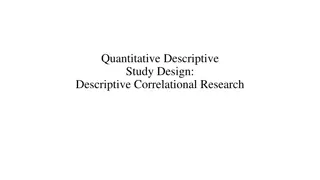
Understanding Quantitative Research Design
Dive into the world of quantitative research design with Dr. Vijayalekshmi N., Assistant Professor at Fathima Memorial Training College. Explore the definitions, key features, steps, types, strengths, limitations, and ethical issues of quantitative research design. Enhance your knowledge and skills to define, understand, and analyze quantitative research effectively.
Download Presentation

Please find below an Image/Link to download the presentation.
The content on the website is provided AS IS for your information and personal use only. It may not be sold, licensed, or shared on other websites without obtaining consent from the author. If you encounter any issues during the download, it is possible that the publisher has removed the file from their server.
You are allowed to download the files provided on this website for personal or commercial use, subject to the condition that they are used lawfully. All files are the property of their respective owners.
The content on the website is provided AS IS for your information and personal use only. It may not be sold, licensed, or shared on other websites without obtaining consent from the author.
E N D
Presentation Transcript
Quantitative research design Dr. VIJAYALEKSHMI N S ASSISTANT PROFESSOR M.Ed DEPARTMENT FATHIMA MEMORIAL TRAINING COLLEGE KOLLAM, KERALA STATE
Quantitative research design Quantitative research is a systematic empiricalinvestigation of a social phenomena with statistical and numerical data and techniques
contents Quantitative Research Design-Definitions The Concept of Quantitative Research Design Key Features of Quantitative Research Design Steps of Quantitative Research Design Types of Quantitative Research Designs Strengths of Quantitative Research Design Limitations of Quantitative Research Design Ethical issues related to Quantitative Design
LEARNING OBJECTIVES The student teachers will be able to, define quantitative research understand the concept of quantitative research describe the key characteristics of quantitative design differentiate various types of quantitative designs list the basic steps of quantitative design analyse the strengths and limitations of the design identify the ethical issues involved in quantitative design
Quantitative research --definitions Quantitative research is an inquiry into a social problem, explain phenomena by gathering numerical data that are analyzed using mathematically based methods e.g. in particular statistics . The researcher primarily uses post-positivist approach to develop knowledge when quantitative research is selected (i.e cause and effect thinking, use of measurement and observations, and test of theories), employs strategies of inquiry such as experiments and surveys, and collects data on predetermined instruments yield statistical data Aliaga and Gunderson (2002) Creswell (2003)
Quantitative research - concept Quantitative research is the process of collecting and analyzing numerical data. . It is used to quantify attitudes, opinions, behaviors, and other defined variables Quantitative data collection methods are much more structured It can be used to find patterns and averages, make predictions, test causal relationships The design generalize results to wider populations. .
main characteristics are main characteristics are: The data is usually gathered using structured research instruments. The results are based on larger sample sizes that are representative of the population. The research study can usually be replicated or repeated, given its high reliability. Researcher has a clearly defined research question to which objective answers are sought. All aspects of the study are carefully designed before data is collected.
main characteristics are main characteristics are: Data are in the form of numbers and statistics, often arranged in tables, charts, figures, or other non-textual forms. Project can be used to generalize concepts more widely, predict future results, or investigate causal relationships. Researcher uses tools, such as questionnaires or computer software, to collect numerical data.
Steps of quantitative research design Identification of problem-Quantitative studies tend to narrow in scope focussing on a handful of key variables Statement of hypothesis-hypothesis are stated clearly and precisely Review of related literature-to find out what others have done and identify gaps Development of research plan-a complete research plan based on hypothesis sampling strategies and data collection procedures
Steps of quantitative research design Collection of data-using structured instruments viz; questionnaires, rating scales, inventories etc Analysis of data-data statistically analysed focusing numerical data Conclusion and generalisation-conclusions drawn from interpretation of data Research report-final step which summarises all aspects of study
types of quantitative research designs a) Descriptive Design Descriptive research aim is to identify characteristics, frequencies, trends, and categories. Descriptive research aims to accurately and systematically describe a population, situation or phenomenon It can answer what, when, where, when and how questions, but not why questions. A descriptive research design can use a wide variety of research methods to investigate one or more variables The researcher does not control or manipulate any of the variables, but only observes and measures them. Eg Social Media Usage Among Under Graduate Students
types of quantitative research designs b)Correlational Design Explores the relationship between variables using statistical analyzes.It does not look for cause and effect Mostly observational in terms of data collection. The most prominent feature of correlational research is that the two variables are measured neither is manipulated. A correlation has direction and can be either positive or negative. It can also differ in the degree or strength of the relationship. Eg;Relationship Between Academic Stress and Achievement
types of quantitative research designs c)Experimental Designs . Often referred to as trueexperimentation , this type of research method uses a scientific method to establish cause-effect relationship among a group of variables. It is commonly defined as a type of research where the scientist actively influences something to observe the consequences. It is a systematic and scientific approach to research in which the researcher manipulates one or more variables, and controls/randomizes any change in other variables. Eg;Effectiveness of Metacognitive Instructional Strategies In Enhancing Metacognitive Skills among Higher Secondary School Students
types of quantitative research designs d)Quasi-experimental Research Quasi-experimental research resembles experimental research but is not a true experimental research. It is often referred to as Causal-Comparative . The researcher seeks to establish a cause-effect relationship between two variables and manipulates the independent variable. The independent variable is manipulated, participants are not randomly assigned to conditions or orders of conditions "Quasi-experimental research is similar to experimental research in that there is manipulation of an independent variable. It differs from experimental research because either there is no control group, no random selection, no random assignment, and/or no active manipulation." Quasi-experimental involves comparison. The study of two or more groups is done without focusing on their relationship.
types of quantitative research designs e)Survey Design Survey research is a quantitative research method which assess statistical relationships between variables Ask the participants to report directly on their own thoughts, feelings, and behaviours. Survey researches have a strong preference for large random samples because they provide the most accurate estimates of what is true in the population. Eg;Attitude of Secondary School Students Towards Environment
Strengths of quantitative research design More scientific: A large amount of data is gathered and then analyzed statistically. Control-sensitive: The researcher has more control over how the data is gathered and is more distant from the experiment. Less biased/objective: The research aims for objectivity i.e. without bias, and is separated from the data. Focused: The design of the study is determined before it begins and research is used to test a theory and ultimately support or reject it. Repeatable: The research study can usually be replicated or repeated, given its high reliability.
Strengths of quantitative research design Deals with larger samples: The results are based on larger sample sizes that are representative of the population. The large sample size is used to gain statistically valid results in customer insight. More structured: Researcher uses structured tools, such as questionnaires, inventories, rating scales, to collect numerical data. Arranged in simple analytical methods: Received data are in the form of numbers and statistics, often arranged in tables, charts, figures, or other non- textual forms. Generalizable: to generalize concepts more widely, predict future results, or investigate causal relationships. Findings can be generalized if selection process is well-designed and sample is representative of a study population.
Limitations of quantitative research Requires extensive statistical analysis Limited outcomes due to structured method Inability to control the environment Time consuming and costly nature of data collection The difficulty of replicating findings The problem of ethics-entering into the personal world of participant
Limitations of quantitative research Quantitative data is more efficient and able to test hypotheses, but may miss contextual detail Uses a static and rigid approach and so employs an inflexible process of discovery The development of standard questions by researchers can lead to "structural bias" and false representation, where the data actually reflects the view of the researcher instead of the participating subject Results provide less detail on behavior, attitudes, and motivation
Ethical considerations of quantitative research Research participants should not be subjected to harm in any ways Respect for the dignity of research participants should be prioritized. Full consent should be obtained from the participants prior to the study. The protection of the privacy of research participants has to be ensured. Adequate level of confidentiality of the research data should be ensured.
Ethical considerations of quantitative research Anonymity of individuals and organizations participating in the research has to be ensured. Any deception or exaggeration about the aims and objectives of the research must be avoided. Any type of communication in relation to the research should be done with honesty and transparency. Any type of misleading information, as well as representation of primary data findings in a biased way must be avoided.
SUMMARY Quantitative research is the systematic empirical investigation of observable phenomena via statistical, mathematical, or computational techniques Quantitative research focuses on objectivity that permits the researcher to generalize findings beyond a particular situation or setting. Approaches to conducting quantitative research include nonexperimental and experimental designs. Nonexperimental research designs comprise techniques where there is no manipulation of any variable in the study. These designs include descriptive research, correlational research, and survey research. The category of experimental research designs includes quasi-experimental designs and true experimental designs Larger samples and structured tools are the strengths of the design Extensive statistical analysis and limited outcomes are the limitations of the design
Suggested readings Bernard, H. R., & Bernard, H. R. (2012). Social research methods: Qualitative and Quantitative Approaches. Sage Publications Creswell, J. W. (2013). Research design: Qualitative, Quantitative, and Mixed Methods Approaches. Sage publications. Gall, M. D., Borg, W. R., & Gall, J. P. (1996). Educational Research: An Introduction . Longman Publishing. Mertens, D. M. (1998). Research Methods in Education and Psychology: Integrating Diversity with Quantitative & Qualitative Approaches. Neuman, W. L., & Neuman, W. L. (2006). Social Research Methods: Qualitative and Quantitative Approaches. Pearson Education Limited Punch, K. F. (2013). Introduction to Social Research: Quantitative and Qualitative Approaches. Sage Publications






















